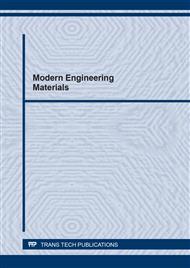p.3
p.9
p.15
p.21
p.29
p.35
p.41
p.47
Nickel Porous Compacts Obtained by Electrical Discharge Consolidation
Abstract:
A commercially pure (c.p.) nickel powder was consolidated by Electrical-Discharge-Consolidation (EDC technique), using an equipment based on the technology developed for the welding industry (stud welding). The main advantage of the EDC technology is its high speed, in the order of the millisecond, which makes it particularly interesting when a high final porosity is aimed, or when the inherent nanostructure of the powders needs to be preserved. The working pressure was 100 MPa, but compacts were consolidated both directly from loose powders and from previously cold pressed green compacts (with 400, 700 and 1000 MPa). The discharge conditions were always fixed (voltage of 200 V, and electrical capacity of 132 mF), but different experiments were carried out varying the number of discharge cycles (5, 10, 15, 20, 25 and 30), maintaining the applied pressure between cycles. Porosity and micro-hardness measurements were carried out on the final compacts.
Info:
Periodical:
Pages:
9-14
Citation:
Online since:
April 2022
Keywords:
Price:
Сopyright:
© 2022 Trans Tech Publications Ltd. All Rights Reserved
Share:
Citation:


